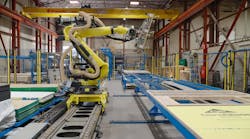Editor's note: This is Part 2 of a two-part series. Part 1 was published in February.
To explain how an energy-management strategy can be used to automatically leverage real-time pricing, we will use the example of price-responsive supply-air-temperature reset. This strategy for cooling is based on predictions — made by neural networks — of space temperature related to the kilowatt demand of devices and current, as well as predicted, real-time energy prices. It determines if supply-air temperature (based on actual energy price) can be increased for 10 to 20 min (depending on the predicted degradation curve learned by the neural network) without space temperature increasing by more than 1 F. If the neural network associated with the air handler shows it can, a higher supply-air-temperature register will be written for the device in the building-management system. Once the 10 to 20 min are up, the value of the register gradually will return to its original setting. If, during the override period, an environmental parameter starts to go to the boundary of the envelope set by the trigger agent, the register's original set point will be resumed immediately.
Customers can indicate the extent to which they are willing to drift temperaturewise. If a single strategy cannot cope with rapidly increasing prices, additional strategies kick in, leveraging various comfort bands to keep energy costs in check.
TOOLS FOR CONFIDENT PARTICIPATION IN DEMAND-RESPONSE PROGRAMS
Demand response can be used to shape load curves — that is, to shift or curtail peak loads — efficiently.
To address the upside and downside of demand-response programs, the agents introduced in Part 1 of this series can be given a “goal” in terms of a kilowatt and comfort range. The demand-response module leverages intelligence and forecasting capabilities to:
-
Identify where demand can be shifted temporarily without causing loss of comfort.
-
Implement necessary actions automatically, thus, eliminating error-prone and cumbersome manual emergency curtailment procedures.
Upon receiving a call for curtailment, energy operators “dial” the desired kilowatt-demand reduction into the system. Before issuing an order to curtail to the intelligent agents, they run a simulation of how the curtailment will be achieved. Human operators need neither a pre-established curtailment plan nor to change set points on individual pieces of equipment.
The agents determine where in a portfolio an energy curtailment can be found with the least loss of comfort. By applying strategies such as load rotation, supply-air reset, fan-speed reset, precooling, etc., agents craft a curtailment plan that is optimal for a given moment in time. The agents take all available parameters, such as outside-air temperature, set points, and occupation, into consideration.
Figure 2 shows a 1.1-mw reduction in a 5.6-mw portfolio achieved over 4 hr with an additional 2 F in the space-air-temperature envelope.
Dirk E. Mahling, PhD, is chief technology officer and chief information officer of WebGen Systems. For more than 15 years, he has been contributing to the fields of artificial intelligence, knowledge management, Internet architecture, and graphical user interfaces through numerous articles in the trade press and academic journals and frequent speaking engagements.








